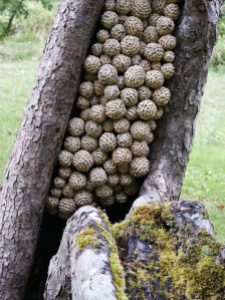
We all know Aristotle’s famous saw, “Art imitates life.” But more intriguing is how he finishes the thought: “Art not only imitates nature, but also completes its deficiencies.” Thus begins the debate on how artists imitate, reproduce and alter reality, and fill in the gaps with their own aesthetic DNA.
Mixed-media artist, Anastasia Zielinski, and environmental artist, Barbara De Pirro, take different approaches to this question in new installations at the Woolworth Windows. Zielinski has created a universe aglitter with dark matter in her Spaceworks installation, Bright Light Heavy. At first glance, Bright Light Heavy suggests a Big Bang galaxy spawned by a “Studio 54” aesthetic blueprint: sequined and metallic fabrics spill liquidly across surfaces; mirrors and reflective foils look like cooling metals that roiled forth from the almighty explosion of a mirrored disco ball. The installation practically throbs with light.
 But Zielinski’s art does not arrive out of chaos; her gorgeous, steel-toned composition made with tricky-to-handle materials forms a landscape intended to mirror internal conditions – and the memory of a striking Northwest day. “I understand the world through light, color, texture and surface and explore these elements equally in my work,” she says. “I aspire to create work that instigates a moment of pause from the everyday, that creates a sense of joy.”
But Zielinski’s art does not arrive out of chaos; her gorgeous, steel-toned composition made with tricky-to-handle materials forms a landscape intended to mirror internal conditions – and the memory of a striking Northwest day. “I understand the world through light, color, texture and surface and explore these elements equally in my work,” she says. “I aspire to create work that instigates a moment of pause from the everyday, that creates a sense of joy.”
Long, sinuous pieces of shiny sapphire and silver fabric flow over mirrored tiles creating the installation’s internal dynamism, and subverting ideas of natural landscape with man-made materials that resonate with glowering color. “Bright Light Heavy is inspired by the view from my porch on Beacon Hill” in Seattle, she says. “There was a big heavy grey cloud hanging over the Sound [one] day in late October, and both the Sound and the sky were slate gray, except for a slice of brilliant golden light breaking through right above the Olympics…It was magical.”

World travel has influenced the graduate of the Pratt Institute, in New York, and can be seen in the lush, textural paintings on her website. “My pieces are either based on real places in nature that amaze me or imagery from my dreams. I try to visually and physically recreate these places through light, color and texture.” Spaceworks barely caught up with Zielinksi via e-mail: “I’m currently on honeymoon in the Philippines! In fact, I finished Bright Light Heavy just a few days before my New Year’s Eve wedding…I wouldn’t recommend doing an installation right before your wedding, but I knew I could do it….The people of Tacoma were so supportive during the install, one of the traffic cops even brought me broken mirror from his house. How awesome is that!
“A successful installation draws you in so that you are lost in the details and it transports you to a different place,” she says. We couldn’t agree more.
* * * * *
To return to Aristotle…In his 1923 book, Aristotle, John Herman Randall expounds on the philosopher’s idea of “Art imitates life.” He explains, “Art does better, more successfully, just what nature does or tries to do; it brings that which is possible in materials to a realization, and thus ‘completes nature’.”

Environmental artist Barbara De Pirro creates a sometimes harrowing vision both of what nature is, and what it is being subsumed by: ecological catastrophe. By hand-fabricating biomorphic shapes out of discarded plastic bag and container material, and siting them in natural and built environments, she forces the viewer to consider that this non-organic substance – plastic – has a longer reach and lifespan than the living organisms that compete with it for space in the world and its oceans.
Recently I visited one of De Pirro’s site-specific installations in an outdoor sculpture garden on Camano Island; clusters of crocheted-plastic vines (similar to the ones at left) crept up from the fork of a tree with an effect that was at once eerie, beautiful and slightly repulsive. Like a parasitic plant, the heavy-laden vines clung to the evergreen’s thick trunk, never to decompose.

For her Artscapes project, the Shelton-based artist has created Metamorphosis, a wall of suspended cellular forms glowing with light. She describes it as “an evolving installation comprised of a series of sculptural forms, each representing a metamorphosis, a transformation from the humble into the exceptional.” As nature creates life cell by cell, she says, so she builds her sculptures. From a cache of hundreds of plastic bottles, she carefully cuts the individual shapes by hand, then sutures and weaves them together “until a multifaceted, organic structure takes shape.”
With light emanating from cocoon-like sacs, Metamorphosis seems to offer at least a slim note of hope against darker visions of nature complete. “I am fascinated by the brilliance and resilience of nature while at the same time its fragility and vulnerability,” she says. “I surround myself with its many forms, surfaces and textures. Nature is as much a part of my life as it is the impetus for all my artwork.” -Lisa Kinoshita
You must be logged in to post a comment.